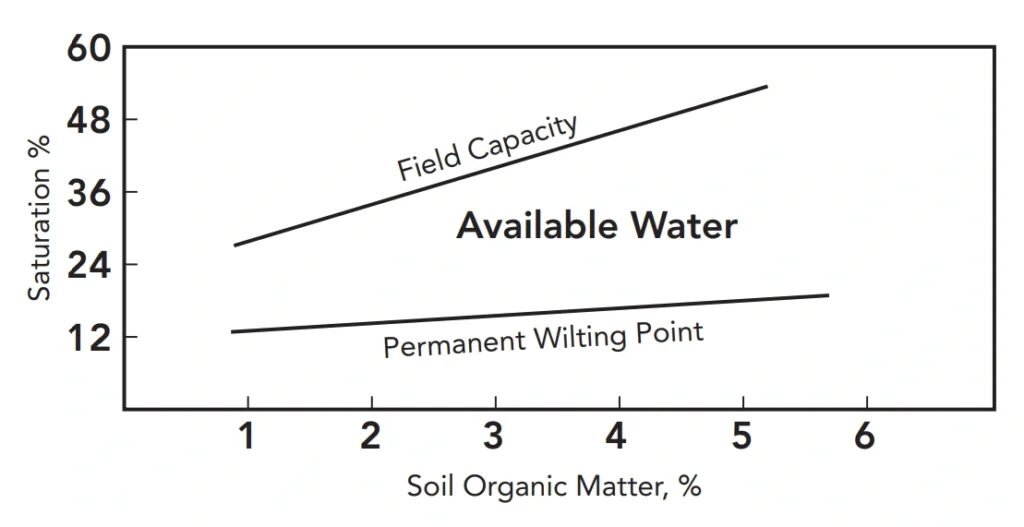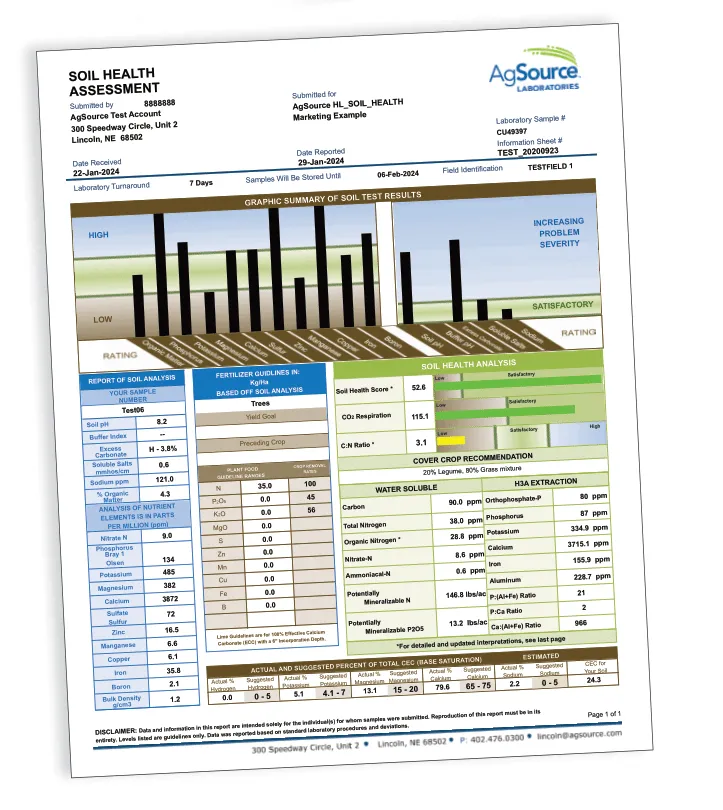How To Understand A Soil Health Assessment
The Soil Health Assessment combines the chemical and physical tests of traditional soil testing with biological assessments of microbial activity to provide a measure of the quality of the soil. The micro-organisms present in soil benefit the crops through decomposition of crop residues and nutrient cycling, but they also compete with plants for available nutrients. Knowing how actively soil micro-organisms react to the availability of nutrients helps to understand crop requirements for the growing season.
A Soil Health Assessment provides a reference point to use in gauging the current quality of a soil and the impact of any management steps taken to improve that quality.

AgSource’s Laboratories Soil Health Assessment includes a standard soil analysis. This focuses on the chemical characteristics of soil fertility. The parameters measured include pH, plant nutrients extracted using traditional methods and cation exchange capacity (CEC). The bulk density of the sample is also determined along with the organic matter percentage and can be used to infer the soil’s ability to provide water to crops over the growing season (see Figure 1). The results from these tests are used to provide fertilizer guidelines and management practices for the desired crop and yield goal. For more information on a standard soil test, refer to the Understanding a Soil Analysis technical bulletin, available at agsource.com.
Recommendations that enhance soil health are based on these biological assessments. Cover crops are recommended as the best way to enhance soil health. By retaining fertilizer nutrients and adding plant residue that easily decomposes, cover crops release nutrients to the soil over a longer period and boost biological activity. When the Soil Health Score is low a cover crop mixture high in legumes is recommended so that nitrogen is added to the soil thus reducing the carbon to nitrogen ratio.
Three Soil Health Options – Basic, Routine and Complete.
All of the assessments include a measure of the biological activity in the soil done by rehydrating a dry soil and measuring the carbon dioxide generated from microbial respiration. A water extraction is also used to determine the soluble forms of carbon and nitrogen. These two nutrients in this form most directly influence bacterial growth in the soil.
The Basic Assessment package includes the following:
The Soil Health Score is calculated from measurements of the rate of microbial respiration and the availability of soluble carbon and organic nitrogen. Combining these into a simple number that ranges from a low of zero up to 50 gives a quick evaluation of health. Increasing this score indicates an improvement in Soil Health. Scores below ten are low, ten to 29 are moderate and above 29 are classified as high. A score above 20 can be considered as very good. This score can be improved by adding easily decomposable organic material or encouraging microbial activity in the soil by reducing tillage operations.
The CO2 Respiration rate is a measure of the microbiological activity in the soil. A dry sample is allowed to slowly absorb water and is kept in a sealed chamber to capture all the carbon dioxide evolved in a 24-hour period. The micro-organism activity is briefly enhanced with this technique allowing this one-day measurement to predict the respiration rate in the soil under normal field conditions. Respiration rates vary depending on the density and diversity of the population as well as on the nutrient supply. An adequate rate of microbial respiration would yield CO2 values from 60 to 300 ppm with values below 60 classified as low and values above 150 considered to be high.

The Organic C:N Ratio is a measure of the availability of two of the most important nutrients for micro-organisms in the soil. Carbon is used as an energy source and nitrogen is a requirement for building proteins and enzymes. Because inorganic forms of N (nitrate and ammonium) fluctuate in the soil solution in relation to fertilizer use, measuring the soluble organic N is a more stable assessment.
A desired Organic C:N ratio of a soil with 3 to 5% organic matter would be between 10 and 15. If the C:N ratio is too high (above 17) then nitrogen limits the growth of the organisms and they will compete with plants for any available source of N. If the ratio is too low (below eight) then the carbon is restricting the growth of micro-organisms and their beneficial activities of nutrient cycling and release are limited. Other benefits from a healthy soil also depend on a balanced organic C:N ratio and include stable organic matter content, improved soil aggregate stability and increased water holding capacity.
Recommendations
Cover Crop Recommendations are formulated to meet two objectives: to provide the soil with easily decomposable plant biomass for better health and to retain the nutrients that are still present in the soil after crop harvest. These recommendations are expressed as various mixtures of grass and legume cover crops. Soils with a low Soil Health Score are improved by establishing more legumes, plants that will biologically fix nitrogen in the soil, thus adding N for a better C:N ratio.
Along with the legumes, it may be beneficial to add a variety of plants such as radishes, turnips or other Brassica species to the proportion designated for grasses as a way to increase the diversity and vigor of the soil microbial life. Soils with a higher Soil Health Score receive a recommendation with fewer legumes and more grass, reflecting the objective to retain the nutrients already in the soil in the biomass of the roots and shoots of the grass.
Table 1.
| Cover Crop Recommendations | |
|---|---|
| If 0 <= SHS < 5.0 then | 70% Legume, 30% Grass mixture |
| If 5.0 <= SHS < 10.0 then | 60% Legume, 40% Grass mixture |
| If 10.0 <= SHS < 15.0 then | 50% Legume, 50% Grass mixture |
| If 15.0 <= SHS < 20.0 then | 40% Legume, 60% Grass mixture |
| If 20.0 <= SHS < 25.0 then | 30% Legume, 70% Grass mixture |
| If SHS > 25.0 then | 20% Legume, 80% Grass mixture |
Table 2.
| Parameter (Water Soluble), ppm | Low | Adequate | High |
|---|---|---|---|
| Carbon | < 150 | 150 – 300 | > 300 |
| Total Nitrogen | < 25.0 | 25.0 – 60.0 | > 60.0 |
| Organic Nitrogen | < 10.0 | 10.0 – 30.0 | > 30.0 |
| Nitrate-N (NO3-N) | < 10.0 | 10.0 – 30.0 | > 30.0 |
| Ammoniacal-N (NH4-N) | < 5.0 | 5.0 – 20.0 | > 20.0 |
The Routine Assessment includes the basic assessment plus …
Water Soluble Extractions
The Water Soluble extraction evaluates the forms of nutrients that are utilized most easily by the organisms and by plants. Carbon and nitrogen are two nutrients that are in high concentration and they regulate the soil’s biological life. Carbon, in soluble and solid forms, supplies the energy for microbial growth. The water extraction of Total Nitrogen includes both the organic and inorganic forms. Organic forms of nitrogen include soluble organic matter, proteins and other by-products of decomposition. Inorganic nitrate nitrogen is easily leached from the soil with water movement and can be converted to gas if the soil is saturated with water. Ammonium is another inorganic form of nitrogen but it is retained in the soil by adsorption on the clay particles where it can be utilized by plants and micro-organisms or converted to nitrate. Organic forms of nitrogen are converted to inorganic forms as byproducts of the biological processes naturally occurring in the soil.
Mineralizable N is determined from the water extractable quantities of carbon and organic nitrogen, and the observed rate of microbial respiration compared to the soluble carbon sources in the soil. When soluble organic nitrogen or the respiration rate increase then this estimated value is higher. This potential release of nitrogen from organic sources compliments the AgSource Laboratories nitrogen fertilizer guidelines that are provided for crops. Those standard fertilizer recommendations include credits for organic matter contributions (10 to 20 lbs N per 1% OM), legume crop residue (up to 40 lbs N) and any nitrate available at the time of testing. The Mineralizable N reported from a Soil Health Test indicates the potential amount nitrogen that could become available from the soil’s organic sources. A healthy soil will release this nitrogen through biological activity over the course of the growing season.
Figure 1. Water holding capacity as influenced by organic matter

Table 3.
| Parameter | Low | Adequate | High |
|---|---|---|---|
| Orthophosphate-P, ppm | <10 | 10 – 20 | >20 |
| Phosphorus, ppm | <15 | 15 – 25 | >25 |
| Potassium, ppm | <40 | 40 – 60 | >60 |
| P:(Al+Fe) Ratio, % | >5 | ||
| P:Ca Ratio, % | >3 | ||
| Ca:(Al+Fe) Ratio, % | >200 |
The Mineralizable P is an estimate of the phosphorus that will be released when these same organic matter sources are decomposed during the growing season. Fertilizer guidelines for phosphorus provided with the standard soil test also take into account both the effect of P fixation by the soil (losses) and releases of P from crop residues (gains). This estimate in the Soil Health analysis indicates the potential release of P from from organic sources in the soil. But bear in mind that a portion of the released P will also be fixed by soil minerals. Therefore the value reported will tend to over-estimate the potential P availability. Note that the reported Mineralizable P is expressed as lbs of P2 O5 so that the value is more easily related to customary fertilizer recommendations.
The Complete Soil Health Assessment also includes …
H3A Extration
The H3A extraction is the third assessment. This is an extraction of the soil sample with a weak combination of citric, malic and oxalic acids. This combination is used to mimic the acids secreted from plant roots during growth. This H3A extraction, often called the ‘Haney Extract’ evaluates the concentration of plant nutrients in the form and concentrations present at the root surfaces. Results from this test help to identify low nutrient availability and imbalances in the soil.
The value reported as Phosphorus measures all of the P extracted by the H3A solution, both the Orthophosphate-P and forms bound to organic compounds. The organic portion of the extracted P is a form that can be utilized after it is made plant-available by activity of micro-organisms through a process called mineralization. This is the source of phosphorus expressed as Mineralizable P in paragraph above. Comparison of the H3A extracted P with the P reported in the soil analysis will give a good indication of the P status of the soil. Phosphorus fertilizer guidelines are based on the standard soil test P results.
Extracted amounts of K and Ca are lower than those reported in the standard soil test because of the weaker extracting characteristics of the H3A solution. Calibrations of this H3A extract for making crop fertilizer recommendations are not available, therefore recommendations are based on the standard soil test results. Concentrations of Iron (Fe) and Aluminum (Al) are used in determining the ratios of these elements to P and Ca to reveal the potential for P fixation, as discussed below. No ranges are given for calcium or these elements because the data has not been related to crop requirements.

Phosphorus fertilizer guidelines take into consideration the efficiency of fertilizer applications caused by the tendency of soil minerals to remove P from soil solution. The ratio of P to aluminum plus iron evaluates this ability of the soil to remove or ‘fix’ applied phosphorus in forms that are insoluble and unavailable to plants. A value below 5 percent indicates a greater tendency for this to take place and is associated with acidic soil.
The P:Ca ratio is a similar evaluation of the tendency of the soil to remove P as a calcium phosphate. The risk of this increases in high pH soil and when the ratio is below 3 percent. The Ca:Al+Fe comparison shows the potential for improving the availability of P through lime application. If the value is below 200 there is a greater possibility that liming will enhance phosphorus uptake.
Conclusion
Soil Health includes the chemical, physical and biological characteristics of the soil. A Soil Health Assessment provides a measure of these characteristics so that they can be managed and improved. A typical first-step recommendation to improve soil health is to grow a cover crop. This will help to retain nutrients, enable vigorous soil microbial growth throughout the year and will build soil organic matter content. Other beneficial practices include reducing tillage or converting to no-till operations, adding a hay crop or pasture into an extended cropping rotation and applying manure in ways that maximize the nutrient and organic benefit to the soil.
Anything that builds organic matter and maintains a readily decomposable nutrient source for an active microbial population in the soil will improve soil health. This in turn will enhance the overall quality of the soil, maximizing the productive capacity of the land.
